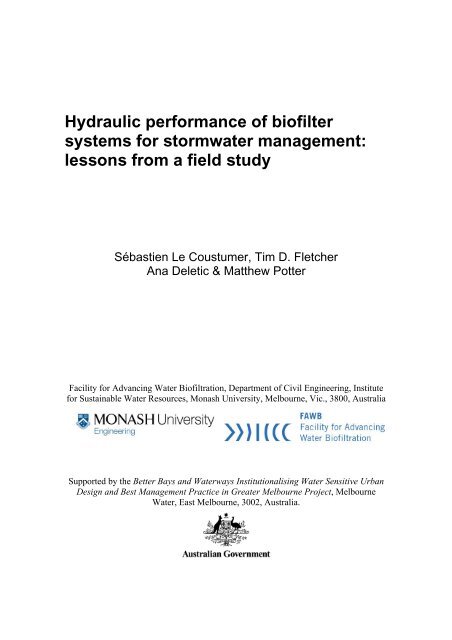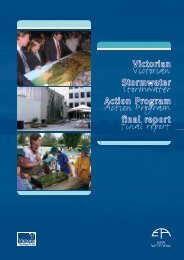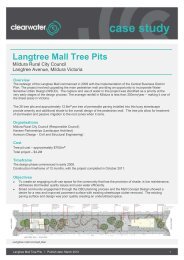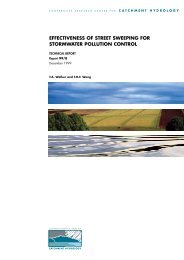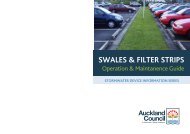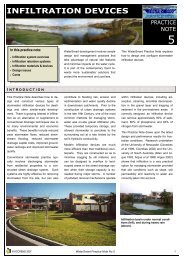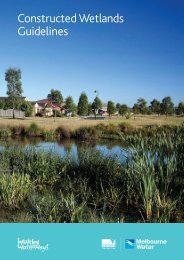Hydraulic performance of biofilter systems for stormwater management
Hydraulic performance of biofilter systems for stormwater management
Hydraulic performance of biofilter systems for stormwater management
Create successful ePaper yourself
Turn your PDF publications into a flip-book with our unique Google optimized e-Paper software.
<strong>Hydraulic</strong> <strong>per<strong>for</strong>mance</strong> <strong>of</strong> bi<strong>of</strong>ilter<br />
<strong>systems</strong> <strong>for</strong> <strong>stormwater</strong> <strong>management</strong>:<br />
lessons from a field study<br />
Sébastien Le Coustumer, Tim D. Fletcher<br />
Ana Deletic & Matthew Potter<br />
Facility <strong>for</strong> Advancing Water Bi<strong>of</strong>iltration, Department <strong>of</strong> Civil Engineering, Institute<br />
<strong>for</strong> Sustainable Water Resources, Monash University, Melbourne, Vic., 3800, Australia<br />
Supported by the Better Bays and Waterways Institutionalising Water Sensitive Urban<br />
Design and Best Management Practice in Greater Melbourne Project, Melbourne<br />
Water, East Melbourne, 3002, Australia.
This study was undertaken under the Facility <strong>for</strong> Advancing Water Bi<strong>of</strong>iltration, as part<br />
<strong>of</strong> PROJECT 4: DEMONSTRATION AND TESTING (ACTIVITY 4.03: Investigation<br />
into the long term sustainability <strong>of</strong> <strong>stormwater</strong> bioretention <strong>systems</strong>). It was supported<br />
by funding through the Better Bays and Waterways - Institutionalising Water Sensitive<br />
Urban Design and Best Practice Management in greater Melbourne project. Funding<br />
partners are the Australian Government through the Coastal Catchment Initiative funded<br />
through the Natural Heritage Trust, Department <strong>of</strong> Sustainability and Environment,<br />
Melbourne Water, Clearwater and the City <strong>of</strong> Kingston.<br />
April 2008<br />
Contact details:<br />
Sebastien.le.coustumer@eng.monash.edu.au<br />
Tim.fletcher@eng.monash.edu.au<br />
Ana.deletic@eng.monash.edu.au<br />
matthew.potter@melbournewater.com.au<br />
2
Executive summary<br />
Bi<strong>of</strong>iltration <strong>systems</strong> (‘bi<strong>of</strong>ilters’) are increasingly being used to manage<br />
polluted <strong>stormwater</strong> run<strong>of</strong>f in urban areas. However, there are significant concerns<br />
about their lifespan, particularly due to the possibility <strong>of</strong> clogging <strong>of</strong> the <strong>systems</strong> over<br />
time. A study <strong>of</strong> 37 bi<strong>of</strong>ilters constructed on the east coast <strong>of</strong> Australia during the last<br />
seven years, shows that 60% <strong>of</strong> constructed <strong>systems</strong> have a saturated hydraulic<br />
conductivity (K) which meets or exceeds the currently recommended range <strong>of</strong> 50 to 200<br />
mm/h. It appears that the media used varied greatly between <strong>systems</strong>, perhaps because<br />
<strong>of</strong> a lack <strong>of</strong> available guidelines at the time <strong>of</strong> construction, or because <strong>of</strong> inadequate<br />
specification and quality control. However, this generally does not affect the treatment<br />
efficiency <strong>of</strong> the <strong>systems</strong>, as most <strong>systems</strong> surveyed were sufficiently sized (in filter<br />
area or ponding volume) such that their detention storage volume compensates <strong>for</strong><br />
reduced media hydraulic conductivity (Figure 1). Consideration <strong>of</strong> the interaction<br />
between these three design elements – hydraulic conductivity, filter area and detention<br />
(ponding depth) – is critical (rather than consideration <strong>of</strong> one factor in isolation).<br />
filter media<br />
hydraulic<br />
conductivity<br />
conductivity<br />
extended<br />
detention<br />
depth<br />
infiltration<br />
capacity<br />
filter<br />
surface<br />
area<br />
Figure 1. Interaction between media hydraulic conductivity and other design components, in<br />
determining infiltration capacity <strong>of</strong> the bioretention system.<br />
The study broadly reveals two types <strong>of</strong> <strong>systems</strong>: some with a high initial K<br />
(>200 mm/h) and some with a low initial K (
change occurs over time. Two hypotheses could explain this phenomenon: on one hand<br />
sediment depositions could be leading to the clogging <strong>of</strong> the surface <strong>of</strong> the system;<br />
another possibility is that the creation <strong>of</strong> macropores through root growth and dieback<br />
may help to minimise the reduction in K. The impact <strong>of</strong> surface clogging is<br />
proportionally greater in <strong>systems</strong> which started with a high initial K, most likely<br />
because the difference in particle size distribution between the original filter media and<br />
deposited sediments will be greater where the original media was coarse. In the <strong>systems</strong><br />
with low initial K, the finer particle size distribution will be more similar to that <strong>of</strong> the<br />
inflow sediments (although still considerably larger), thus reducing the proportional<br />
impact <strong>of</strong> any surface clogging effect.<br />
Site characteristics such as filter area as a proportion <strong>of</strong> catchment area, age <strong>of</strong><br />
the system and inflow volume were not found to be useful predictors <strong>of</strong> media<br />
conductivity, with initial conductivity <strong>of</strong> the original media explaining the vast majority<br />
<strong>of</strong> variance. It is clear there<strong>for</strong>e, that strict attention must be paid to the specification <strong>of</strong><br />
original filter media, to ensure that it satisfies current design requirements. Media<br />
should be tested after construction <strong>of</strong> the system.<br />
Given the apparent difficult in specifying and maintaining hydraulic conductivity<br />
in bi<strong>of</strong>iltration media, one approach is to use a “contingency factor” in the specification<br />
<strong>of</strong> hydraulic conductivity <strong>for</strong> bi<strong>of</strong>iltration <strong>systems</strong>. For example, where the design<br />
intent is to use a soil media with a hydraulic conductivity <strong>of</strong> 180 mm/hr, sizing <strong>of</strong> the<br />
system should be undertaken assuming a hydraulic conductivity <strong>of</strong> 50% <strong>of</strong> the design<br />
value (ie. 90 mm/hr). In this way, if the media does not meet specifications, or shows a<br />
decline in hydraulic conductivity over time, the overall system <strong>per<strong>for</strong>mance</strong> will remain<br />
satisfactory.<br />
Key words: Bi<strong>of</strong>ilters, clogging, <strong>stormwater</strong> <strong>management</strong>, hydraulic conductivity<br />
4
Table <strong>of</strong> contents<br />
1 Introduction .............................................................................................................. 6<br />
2 Method...................................................................................................................... 9<br />
2.1 Sampling locations ........................................................................................... 9<br />
2.2 Sampling methodology..................................................................................... 9<br />
Single ring field infiltration test (shallow test)....................................................... 10<br />
Deep ring field infiltration test ................................................................................ 11<br />
Laboratory infiltration test...................................................................................... 12<br />
Limitations <strong>of</strong> the sampling methods...................................................................... 12<br />
2.3 Data analysis................................................................................................... 13<br />
3 Results and discussion............................................................................................ 15<br />
3.1 Bi<strong>of</strong>ilter design ............................................................................................... 15<br />
3.2 Comparing field methods ............................................................................... 18<br />
3.3 Comparing field and laboratory methods ....................................................... 19<br />
3.4 Clogging <strong>of</strong> <strong>systems</strong> over time ....................................................................... 20<br />
3.5 Influence <strong>of</strong> system characteristics and hydraulic <strong>per<strong>for</strong>mance</strong>..................... 23<br />
4 Conclusions ............................................................................................................ 25<br />
5 Acknowledgments .................................................................................................. 26<br />
6 References .............................................................................................................. 27<br />
5
1 Introduction<br />
Bi<strong>of</strong>iltration <strong>systems</strong> (also called bioretention <strong>systems</strong>, bi<strong>of</strong>ilters or rain gardens)<br />
have been widely implemented in the last few years as a source control technique to<br />
manage <strong>stormwater</strong> run<strong>of</strong>f in urban areas (Melbourne Water, 2005). They <strong>for</strong>m one<br />
technique in the suite <strong>of</strong> tools which aim to reduce the impact <strong>of</strong> urbanisation on<br />
watersheds (Dietz and Clausen, 2007).<br />
In Australia, they are commonly used to treat run<strong>of</strong>f in urbanizing areas and as a<br />
retr<strong>of</strong>it technique in already-developed areas. With increasing societal pressure to<br />
protect and restore the environmental quality <strong>of</strong> aquatic ecosystem (Brown and Clarke,<br />
2007), local water authorities are encouraging their development and construction.<br />
Bi<strong>of</strong>ilters have been shown to be effective in the treatment <strong>of</strong> suspended<br />
sediments, heavy metals and nutrients (Zinger et al. 2007). However, there remain<br />
significant questions about the sustainability and long-term <strong>per<strong>for</strong>mance</strong> <strong>of</strong> bi<strong>of</strong>ilters,<br />
with little field data available.<br />
Australian guidelines <strong>for</strong> bi<strong>of</strong>ilter design generally recommend a saturated<br />
hydraulic conductivity (K) <strong>of</strong> between 50 and 200 mm/h <strong>for</strong> the filter media (e.g.<br />
Melbourne Water, 2005). Bi<strong>of</strong>ilters are then designed in order to achieve pollutant<br />
removal efficiency <strong>for</strong> total suspended solids (TSS), total nitrogen (TN) and total<br />
phosphorus (TP), as described in Table 1. Curves giving the percentage <strong>of</strong> pollutant<br />
removal versus the size <strong>of</strong> bi<strong>of</strong>ilter <strong>for</strong> different detention depth have been developed, to<br />
determine required area and detention volume (Melbourne Water, 2005). As an<br />
example, in the Melbourne area, if a 300 mm detention depth is assumed, a bi<strong>of</strong>ilter has<br />
to be sized at approximately 1.65% <strong>of</strong> the impervious catchment in order to achieve a 45<br />
% TN removal (the limiting <strong>per<strong>for</strong>mance</strong> target required by regulations in several<br />
Australian states).<br />
Table 1: Quality objectives <strong>for</strong> <strong>stormwater</strong> treatment in Victoria (Victoria <strong>stormwater</strong> committee, 1999)<br />
Pollutants<br />
TSS<br />
TP<br />
TN<br />
Objective<br />
80% retention <strong>of</strong> annual loading<br />
45% retention <strong>of</strong> annual loading<br />
45% retention <strong>of</strong> annual loading<br />
6
The potential <strong>for</strong> clogging <strong>of</strong> the surface <strong>of</strong> the <strong>systems</strong> is a real issue (Bouwer,<br />
2002). A field survey <strong>of</strong> a number <strong>of</strong> infiltration <strong>systems</strong> (which un<strong>for</strong>tunately did not<br />
include raingardens or any other <strong>for</strong>m <strong>of</strong> bi<strong>of</strong>ilters) conducted by Lindsey et al. (1992)<br />
showed that only 38% <strong>of</strong> infiltration basins were functioning as designed after 4 years<br />
<strong>of</strong> operation, with 31% considered to be clogged. Schueler et al. (1992) showed that<br />
50% <strong>of</strong> infiltration <strong>systems</strong> were not working due to clogging. Clogging results in more<br />
frequent overflows and there<strong>for</strong>e a decrease in treatment capacity, since less <strong>of</strong> the<br />
annual flow volume filters through the media. Clogging may also cause problems <strong>of</strong><br />
stagnant water and aesthetic problems, leading to difficulties in acceptance <strong>of</strong><br />
bi<strong>of</strong>iltration as a system integrated into the built environment.<br />
To illustrate the impact <strong>of</strong> the variation <strong>of</strong> K on the <strong>per<strong>for</strong>mance</strong> <strong>of</strong> the system, the<br />
Model <strong>for</strong> Urban Stormwater Improvement Conceptualisation (MUSIC v3.02) s<strong>of</strong>tware<br />
was used to model a hypothetical catchment <strong>of</strong> 1 ha (100% impervious) located in<br />
Melbourne, draining into a bi<strong>of</strong>ilter designed at 1% <strong>of</strong> the catchment area, and with a<br />
ponding depth <strong>of</strong> 10 cm. As shown in Figure 1, the percentage <strong>of</strong> mean annual flow<br />
treated (called ‘hydrologic effectiveness’; Wong et al. 1999) decreases with K. For a K<br />
<strong>of</strong> 200 mm/h, the hydrologic effectiveness is 85%; falling to 58% <strong>for</strong> K <strong>of</strong> 50 mm/h and<br />
to 29% <strong>for</strong> K <strong>of</strong> 5 mm/h. When bi<strong>of</strong>ilters are severely clogged (<strong>for</strong> example when K is 5<br />
mm/h), 71% <strong>of</strong> inflows are discharged effectively untreated to receiving waters.<br />
Removal <strong>of</strong> TN load / Hydrological Effectiveness [% <strong>of</strong><br />
annual inflows]<br />
100<br />
90<br />
80<br />
70<br />
60<br />
50<br />
40<br />
30<br />
20<br />
10<br />
0<br />
Hydrological effectiveness<br />
TN reduction<br />
1 10 100 1000<br />
<strong>Hydraulic</strong> conductivity (mm/h)<br />
Figure 1 : Evolution <strong>of</strong> Hydrological effectiveness and TN reduction vs. <strong>Hydraulic</strong> conductivity<br />
7
In this context, the objectives <strong>of</strong> this study are to:<br />
• Evaluate the hydraulic conductivity and the design <strong>of</strong> a large number <strong>of</strong><br />
<strong>systems</strong> already built in order to assess their <strong>per<strong>for</strong>mance</strong> regarding current<br />
guidelines,<br />
• Assess the evolution <strong>of</strong> hydraulic conductivity in order to estimate the<br />
variation <strong>of</strong> their <strong>per<strong>for</strong>mance</strong> with time,<br />
• Gather a large dataset on different <strong>systems</strong> in order to understand the<br />
possible influence <strong>of</strong> some factors (i.e. catchment size, bi<strong>of</strong>ilter size, age…)<br />
on their <strong>per<strong>for</strong>mance</strong>.<br />
• Provide guidance on the design and construction <strong>of</strong> rain-gardens, based on<br />
findings <strong>of</strong> the survey.<br />
8
2 Method<br />
2.1 Sampling locations<br />
Thirty-seven bi<strong>of</strong>ilters were sampled over 18 sites, in Melbourne, Sydney and<br />
Brisbane. Measurements were taken in order to represent as well as possible any spatial<br />
variability in hydraulic conductivity. Usually three measurements were taken in each<br />
bi<strong>of</strong>ilter, most <strong>of</strong> the bi<strong>of</strong>ilters tested being less than 40 m² in area (Table 2).<br />
The sites were deliberately chosen to have different characteristics. Impervious<br />
catchment and bi<strong>of</strong>ilter size were measured <strong>for</strong> each. The distributions <strong>of</strong> the main<br />
characteristics <strong>of</strong> the sites (catchment location, type and size, and bi<strong>of</strong>ilter size) are<br />
presented in Table 2. The volume <strong>of</strong> water, the volume <strong>of</strong> water received by the system<br />
every year and the total volume <strong>of</strong> water per m² <strong>of</strong> bi<strong>of</strong>ilter were calculated with the<br />
following hypotheses: an average annual precipitation (Bureau <strong>of</strong> Meteorology):<br />
• Melbourne: 650 mm/h<br />
• Brisbane: 1200 mm/h<br />
• Sydney: 1175 mm/h<br />
• An annual run<strong>of</strong>f coefficient <strong>of</strong> 0.8 (to account <strong>for</strong> initial losses, etc).<br />
Table 2: Site characteristics<br />
Location # <strong>of</strong> sites Catchment use # <strong>of</strong> sites Catchment size # <strong>of</strong> sites Bi<strong>of</strong>ilter size # <strong>of</strong> sites<br />
Melbourne 30 Residential 18 < 100m² 6 < 40m² 31<br />
Brisbane 4 Industrial 8 100–1000 m² 17 40–400 m² 4<br />
Sydney 3 Parking 5 1000-10000 m² 9 > 400 m² 2<br />
Highway 4 > 10 000 m² 1<br />
Low traffic road 2<br />
2.2 Sampling methodology<br />
A number <strong>of</strong> alternative methods were used (<strong>for</strong> comparative purposes) <strong>for</strong><br />
determination <strong>of</strong> hydraulic conductivity. Field hydraulic conductivity (K fs )<br />
measurement <strong>of</strong> bi<strong>of</strong>ilters, have been conducted by two different methods (used <strong>for</strong><br />
cross-checking the measurements):<br />
9
(1) a single ring shallow infiltrometer (referred to herein as K fs shallow ), and<br />
(2) a deep ring infiltrometer (herein referred to as K fs deep ).<br />
Laboratory measurements <strong>of</strong> hydraulic conductivity were also conducted on two<br />
types <strong>of</strong> samples:<br />
(1) surface samples (K lab surf ), and<br />
(2) samples taken from deep in the filter media (at a depth <strong>of</strong> approximately 150<br />
mm below the surface - referred to as K lab deep ini )<br />
Whilst the surface measurement reflects the current effective hydraulic<br />
conductivity <strong>of</strong> the system, the deep sample provides an estimate <strong>of</strong> the initial hydraulic<br />
conductivity <strong>of</strong> the media. Methods used <strong>for</strong> determining each <strong>of</strong> these measures are<br />
described in more detail in subsequent sections.<br />
Single ring field infiltration test (shallow test)<br />
The single ring infiltrometer test has been widely described in the literature (see<br />
Reynolds and Elrick, 1990, Youngs et al. 1993 <strong>for</strong> example) and thus only a brief<br />
summary is given here. This method measures the hydraulic conductivity at the surface<br />
<strong>of</strong> the soil (and thus is most appropriate when the hydraulic conductivity is controlled<br />
by a limiting layer at the media surface).<br />
The single ring infiltrometer consists <strong>of</strong> a small plastic ring, with a diameter <strong>of</strong><br />
100 mm that is driven 50 mm into the soil (Figure 2). It is a constant head test that is<br />
conducted <strong>for</strong> two different pressure heads (50 mm and 150 mm). The experiment is<br />
stopped when the infiltration rate is considered steady (i.e. when the volume poured per<br />
time interval remains constant <strong>for</strong> at least 20 minutes).<br />
In order to calculate K fs , a ‘Gardner’s’ behaviour <strong>for</strong> the soil was assumed<br />
(Gardner, 1958 in Youngs et al. 1993):<br />
K(<br />
h)<br />
= K fs<br />
e<br />
αh<br />
Eq. 1<br />
Where K - the hydraulic conductivity, h - the negative pressure head and α - a soil pore<br />
structure parameter.<br />
10
K fs is then found using the following analytical expression (<strong>for</strong> a steady flow)<br />
(Reynolds and Elrick, 1990):<br />
H φm<br />
q = K<br />
fs<br />
( 1 + ) +<br />
Eq. 2<br />
πaG<br />
πaG<br />
Where q - the steady infiltration velocity, a -the ring radius, H - the ponding depth, φm -<br />
the matrix flux potential and G a shape factor estimated as:<br />
d<br />
G = 0 .316 + 0.184<br />
a<br />
Eq. 3<br />
Where d - the depth <strong>of</strong> insertion <strong>of</strong> the ring, and a - the ring radius. G is considered to be<br />
independent <strong>of</strong> soil hydraulic conductivity (i.e. K fs and α) and ponding, if the ponding<br />
depth is greater than 50 mm.<br />
Deep test<br />
Shallow test<br />
Constant ponding depth (H)<br />
Possible clogged layer<br />
Media filter (L)<br />
Transition and<br />
drainage layer<br />
To the drainage<br />
system<br />
Figure 2: Sketch <strong>of</strong> a bi<strong>of</strong>ilter with the deep ring and the shallow ring<br />
Deep ring field infiltration test<br />
The deep ring method is based on the lysimetric method as explained in Daniel<br />
(1989), and may be more appropriate if the limiting hydraulic conductivity is found<br />
considerably below the surface. In order to measure the K fs with this method it is<br />
necessary to have a free-draining outflow drain from which the discharge can be<br />
measured. Bi<strong>of</strong>ilters are built effectively as a lysimeter (i.e. with a drainage layer made<br />
<strong>of</strong> gravel and per<strong>for</strong>ated pipe, both <strong>of</strong> which have a flow capacity several orders <strong>of</strong><br />
magnitude higher than the overlying filter media), but it was not feasible to flood each<br />
bi<strong>of</strong>ilter and measure the outflow in the drain. However, by inserting a ring down to the<br />
drainage layer (Figure 2), it is then possible to apply Darcy’s law, assuming the<br />
following hypotheses: flow through the soil is uni-directional (vertical); soil is<br />
11
saturated, we can then assume that the wetting front is going down the drainage layer<br />
and will be as thick as the soil layer and there will be no pressure in the drainage layer<br />
(ie. free drainage is assumed).<br />
Darcy’s law (Eq. 4) can be then used to calculate the hydraulic conductivity.<br />
QL<br />
K fs =<br />
( H LA )<br />
+<br />
Eq. 4<br />
Where L - the length <strong>of</strong> the media filter, H - the ponding depth, Q - the infiltration flow<br />
rate (i.e., added volume <strong>of</strong> water to keep a constant head divided by the time step) and A<br />
the cross sectional area <strong>of</strong> the column.<br />
The cylinder used had a 130 mm internal diameter and was driven up to the gravel<br />
layer. This method is able to measure the hydraulic conductivity <strong>of</strong> the whole system,<br />
and can thus account <strong>for</strong> a limiting layer anywhere in the media depth pr<strong>of</strong>ile.<br />
Laboratory infiltration test<br />
Soil samples were tested according to the Australian standard AS 4419-2003.<br />
Tests were undertaken on disturbed samples (by necessity). Surface samples (called labsurface)<br />
were taken in the first centimetre <strong>of</strong> the soil and deep samples between 10 and<br />
15 cm. Surface samples were used to compare the field and the laboratory method. Deep<br />
samples (called lab-deep) are assumed to represent ‘the initial hydraulic conductivity’<br />
<strong>of</strong> the <strong>systems</strong> because soil has not been changed by sediment deposit (any fine<br />
sediment deposited on the filter is assumed to be trapped within the first few<br />
centimetres <strong>of</strong> the media (Hatt et al, 2006). The dimensions <strong>of</strong> samples tested during the<br />
experiments were 100 mm diameter and 85 mm deep.<br />
Limitations <strong>of</strong> the sampling methods<br />
For both field tests, the main limitations are the possible compaction or<br />
disturbance <strong>of</strong> the soil while the ring is driven into the soil and possible preferential<br />
flow on the side <strong>of</strong> the column. For the deep ring method, it is also possible that the<br />
assumptions <strong>of</strong> saturated conditions at the beginning <strong>of</strong> the experiment, and the freedraining<br />
behaviour <strong>of</strong> the underlying gravel, may not be true in all cases.<br />
12
Laboratory measurements have inherent problem that samples are in all cases<br />
disturbed, and there<strong>for</strong>e impact <strong>of</strong> in-situ soil compaction can not be evaluated.<br />
Although it is clamed that these measurements will give ‘the initial hydraulic<br />
conductivity’, this is not exactly true since soil structure may have been changed over<br />
time (e.g. water flowing through the <strong>systems</strong> over time should have changed soil<br />
structure to some extent).<br />
2.3 Data analysis<br />
Data preparation<br />
For each bi<strong>of</strong>ilter and when multiple tests were conducted, average hydraulic<br />
conductivity and its coefficient <strong>of</strong> variation were calculated <strong>for</strong> each method.<br />
Uncertainties were calculated using the law <strong>of</strong> propagation <strong>of</strong> uncertainty as explained<br />
in NIST, 1994. Data have been logged trans<strong>for</strong>med be<strong>for</strong>e statistical analysis in order to<br />
respect the assumptions <strong>of</strong> normality, which was tested with Kolmogorov-Smirnov test<br />
(K-S test); normality accepted at p>0.05.<br />
Comparison between methods<br />
The results from the two different field methods are compared as well as field<br />
methods and laboratory methods. Paired t-Tests are conducted with results considered<br />
as statistically different when p< 0.05; coefficient <strong>of</strong> correlation (R²) between methods<br />
is also calculated. The laboratory – field comparisons are only made <strong>for</strong> the lab-surface<br />
samples because it is assumed that lab-deep samples represent the initial hydraulic<br />
conductivity and not the current value (Hatt et al., 2006).<br />
Determining clogging over time<br />
As the initial hydraulic conductivity is unknown <strong>for</strong> all the <strong>systems</strong> tested, the<br />
measurement made on the lab-deep samples is assumed to represent the initial hydraulic<br />
conductivity (K lab deep ini ). This value is then compared with the field measurements (K fs<br />
deep and K fs shallow ) and with laboratory measurement made on the surface samples (K lab<br />
surf).<br />
13
Determining the influence <strong>of</strong> catchment characteristics<br />
Ascendant Hierarchical Classification (AHC) was used to show group patterns in<br />
the dataset, and thus to tease out the factors which have significant explanatory power<br />
on the variation observed. It was conducted on the following parameters: K fs shallow , K fs<br />
deep, K lab deep ini , age <strong>of</strong> the system, size ratio, volume <strong>of</strong> water per year, total volume <strong>of</strong><br />
water and total volume <strong>of</strong> water per area (m²) <strong>of</strong> <strong>systems</strong>.<br />
Multiple regressions were used in order to explain the variation <strong>of</strong> K fs shallow as a<br />
function <strong>of</strong> explanatory variables (K lab ini , age, size ratio, volume <strong>of</strong> water per year, total<br />
volume <strong>of</strong> water per m²) in order to understand possible correlation between the current<br />
K and characteristics <strong>of</strong> the system and its catchment.<br />
14
3 Results and discussion<br />
3.1 Bi<strong>of</strong>ilter design<br />
Most <strong>of</strong> the <strong>systems</strong> studied were not designed strictly according to current<br />
guidelines in term <strong>of</strong> ratio size <strong>of</strong> the system/size <strong>of</strong> the catchment (many were<br />
constructed prior to the availability <strong>of</strong> these current guidelines). For example, the<br />
Victorian (Melbourne Water, 2005) guidelines recommend a bi<strong>of</strong>ilter :catchment area<br />
ratio <strong>of</strong> at least 1.65 %, but the 30 Victorian <strong>systems</strong> surveyed show a ratio between<br />
0.1% and 21.9%, with an average <strong>of</strong> 5.3 % and a median <strong>of</strong> 2.5% (Table 3). Bi<strong>of</strong>ilters<br />
are thus generally over sized, although the extended depths are <strong>of</strong>ten considerably less<br />
than the recommended range <strong>of</strong> 100-200mm. However, given their irregular geometry,<br />
exact measurement <strong>of</strong> the ‘effective’ or ‘average’ ponding depth was not feasible.<br />
Field hydraulic conductivity measurement shows that 39% (using the shallow ring<br />
method) (42% using the deep ring method) <strong>of</strong> the bi<strong>of</strong>ilters have a K fs below 50 mm/h,<br />
44% (27%) between 50 and 200 mm/h and 17% (30%) above 200 mm/h (Table 3). In<br />
summary, most <strong>of</strong> the <strong>systems</strong> (~60%) have a hydraulic conductivity either within or<br />
exceeding the currently used guidelines (Melbourne Water, 2005; Wong et al., 2006).<br />
15
Table 3: Data <strong>for</strong> each site: hydraulic conductivity value (different method), catchment characteristics and<br />
volume <strong>of</strong> water received<br />
<strong>Hydraulic</strong> conductivity (mm/h) Sites characteristics Volume <strong>of</strong> water<br />
Sites<br />
K fs shallow ur(K) % K fs deep ur(K) %<br />
K lab deep<br />
(ini)<br />
K lab surf<br />
Age (year)<br />
Catchment<br />
area (m²)<br />
Bi<strong>of</strong>ilter<br />
area (m²)<br />
Ratio (%)<br />
V. water/year<br />
(m3)<br />
Total V. water<br />
(m3)<br />
Total V./ m²<br />
(m)<br />
Streisand Dr, Brisbane 61 29 32 99 399 238 0.5 1105 20 1.8 1060.8 530.4 26.5<br />
Saturn Cr, Brisbane 34 20 38 10 17 9 0.5 675 20 3.0 648.0 324.0 16.2<br />
Donnelly Pl, Brisbane 19 22 63 12 12 0.2 1130 32.2 2.8 1084.8 217.0 6.7<br />
Hoyland Dr, Brisbane 204 16 667 6 65 146 5 17400 860 4.9 16704.0 83520.0 97.1<br />
58 30 68 14 53 0.5 1500 15 1.0 780.0 390.0 26.0<br />
Monash Car park, Clayton<br />
102 22 88 13 117 0.5 1500 15 1.0 780.0 390.0 26.0<br />
45 20 55 15 48 0.5 1500 15 1.0 780.0 390.0 26.0<br />
71 31 406 12 582 31 3 366 14.5 4.0 190.3 571.0 39.4<br />
594 34 444 10 264 3 60 11 18.3 31.2 93.6 8.5<br />
129 34 265 9 462 98 3 560 4.5 0.8 291.2 873.6 194.1<br />
Cremorne St, Richmond<br />
316 34 282 12 747 116 3 622 18 2.9 323.4 970.3 53.9<br />
98 32 100 17 113 28 3 400 10 2.5 208.0 624.0 62.4<br />
119 25 203 9 297 113 3 324 11 3.4 168.5 505.4 45.9<br />
53 26 202 17 151 4 3 84 6 7.1 43.7 131.0 21.8<br />
85 25 140 11 270 102 3 85 10 11.8 44.2 132.6 13.3<br />
49 27 5 50 10 2 68 12 17.6 35.4 70.7 5.9<br />
Aleyne St, Chelsea<br />
35 34 6 39 20 2 112 24.5 21.9 58.2 116.5 4.8<br />
5 29 9 79 21 2 213 17 8.0 110.8 221.5 13.0<br />
19 30 8 50 12 2 163 22 13.5 84.8 169.5 7.7<br />
Point Park, Docklands<br />
Hamilton St, W. Brunswick<br />
139 25 321 7 246 1 410 7 1.7 213.2 213.2 30.5<br />
135 20 77 47 306 1 370 7 1.9 192.4 192.4 27.5<br />
36 14 7 76 5 3 3200 4 0.1 1664.0 4992.0 1248.0<br />
137 34 11 63 11 3 91 1 1.1 47.3 142.0 142.0<br />
13 36 11 47 9 3 120 5 4.2 62.4 187.2 37.4<br />
Avoca Cr, Pascoe Vale<br />
26 34 10 51 11 3 200 4 2.0 104.0 312.0 78.0<br />
44 34 6 59 15 3 310 4 1.3 161.2 483.6 120.9<br />
24 34 23 30 4 3 314 12 3.8 163.3 489.8 40.8<br />
Parker St, Pascoe Vale<br />
19 21 56 13 16 3 157 14 8.9 81.6 244.9 17.5<br />
39 34 1 138 7 3 528 7 1.3 274.6 823.7 117.7<br />
Ceres, West Brunswick 97 19 60 13 2 1257 21.75 1.7 653.6 1307.3 60.1<br />
Bourke St tree pit,<br />
84 23 23 21 1 100 1.44 1.4 52.0 52.0 36.1<br />
Melbourne<br />
Hallam Bypass, Floret Pl 154 24 199 63 3 120<br />
Hallam Bypass, Wanke Rd 115 22 490 387 3 12<br />
Hallam Bypass, Wanke Rd<br />
basin<br />
Wolseley Pd, Vic Park<br />
(NSW)<br />
Leyland Gr, Vic Park<br />
(NSW)<br />
203 27 286 207 3 168<br />
159 18 425 5 376 560 7 1504 330 21.9 1413.3 9893.0 30.0<br />
237 17 398 4 151 224 7 1804 180 10.0 1695.8 11870.3 65.9<br />
2 nd Pond Creek (NSW) 5 21 2000 0<br />
16
The influence <strong>of</strong> this result on the system hydrologic effectiveness is shown by<br />
the MUSIC model results in Figure 3. For a system designed at 2.5 % <strong>of</strong> its catchment<br />
area in Melbourne (which is large by current standards), an extended detention depth <strong>of</strong><br />
30 cm and with a K <strong>of</strong> only 50 mm/h, 74% <strong>of</strong> the mean annual inflow is treated by the<br />
bi<strong>of</strong>ilter. If the system con<strong>for</strong>med with the recommended hydraulic conductivity (K <strong>of</strong><br />
180 mm/hr), it would intercept only 18% more <strong>of</strong> the mean annual flow. In other words,<br />
the observed frequent over-dimensioning <strong>of</strong> filter area compensates <strong>for</strong> the low<br />
hydraulic conductivity, even through detention depths are generally relative shallow in<br />
the <strong>systems</strong> tested. When K fs drops to 5 mm/h, 44% <strong>of</strong> flow is treated (<strong>for</strong> a size <strong>of</strong><br />
2.5%) and 64% <strong>for</strong> a size <strong>of</strong> 5.3%. The key lesson is that over-sizing <strong>of</strong> bi<strong>of</strong>ilter area<br />
will help to ‘buffer’ against unintended reductions in hydraulic conductivity.<br />
Flow treated (%)<br />
100<br />
90<br />
80<br />
70<br />
60<br />
50<br />
40<br />
30<br />
20<br />
10<br />
0<br />
Bi<strong>of</strong>ilter <strong>of</strong> 2.5% <strong>of</strong> Catchment<br />
Melbourne<br />
Sydney<br />
Brisbane<br />
0 50 100 150 200 250 300 350 400 450 500<br />
Ks<br />
K(mm/h)/ Size ratio (%)* 1.65 2.5 5.3<br />
180 85 92 98<br />
50 63 74 90<br />
10 40 51 71<br />
5 34 44 64<br />
* With Melbourne data<br />
Figure 3: Influence <strong>of</strong> the ratio bi<strong>of</strong>ilter/catchment size and <strong>of</strong> the K fs on the ‘hydrologic effectiveness’<br />
At the time <strong>of</strong> this study, no Australian guidelines made explicit<br />
acknowledgement <strong>of</strong> this issue; the interaction <strong>of</strong> hydraulic conductivity, filter area and<br />
ponding depth, in determining the effective infiltration capacity <strong>of</strong> the bi<strong>of</strong>iltration<br />
system (Figure 4). However, in response to this lack, the Facility <strong>for</strong> Advancing Water<br />
Bi<strong>of</strong>iltration (FAWB) recently revised its filter media guidelines, to provide greater<br />
guidance on the interaction between design elements in determining infiltration capacity<br />
(Figure 4). Designers should not consider hydraulic conductivity in isolation, but<br />
rather, should design <strong>systems</strong> using an integrated approach.<br />
17
filter media<br />
hydraulic<br />
conductivity<br />
conductivity<br />
extended<br />
detention<br />
depth<br />
infiltration<br />
capacity<br />
filter<br />
surface<br />
area<br />
Figure 4. Design elements that influence infiltration capacity (source: www.monash.edu.au/fawb).<br />
3.2 Comparing field methods<br />
Statistically both methods give similar results (p=0.38 <strong>for</strong> n=32). Correlation<br />
between two methods is moderately strong with R² = 0.44 (Figure 5). This result can be<br />
explained by the similarity between the two methods, which are both a pressure test<br />
applied on the same surface <strong>of</strong> soil. The differences could be explained by the<br />
uncertainty on each reading (around 30% as shown in Table 3) and by the spatial<br />
variability in the <strong>systems</strong>. Contribution to uncertainty <strong>of</strong> the latter can be evaluated at<br />
50% as shown in Table 4, based on repeated application <strong>of</strong> the hydraulic conductivity<br />
measurements in one system. Since tests have not been conducted in the same spot it<br />
could explain the moderate correlation.<br />
600<br />
Kfs deep (mm/h)<br />
400<br />
200<br />
y = 1.00x + 40.53<br />
R 2 = 0.44<br />
K fs shallow K fs deep<br />
Mean (mm/h) 100 140<br />
σ (mm/h) 115 172<br />
Cv (%) 115% 123%<br />
n 32<br />
p 0.38*<br />
* logged trans<strong>for</strong>med data to respect the normality <strong>for</strong> K fs deep<br />
0<br />
0 200 400 600<br />
Kfs shallow (mm/h)<br />
Figure 5 : Correlation between field methods<br />
18
Table 4 : K value and Cv <strong>for</strong> each site<br />
Shallow method<br />
Deep method<br />
Sites n K (mm/h) Cv (%) n K (mm/h) Cv (%)<br />
Cremorne St, pod7, Richmond 3 119 29 3 203 32<br />
Cremorne St, pod9, Richmond 3 85 55 3 140 54<br />
Parker St, pod 2 Pascoe Vale 3 19 46 3 56 48<br />
Ceres, Brunswick East 4 97 63 4 60 73<br />
Hamilton St pod1, Brunswick West 3 36 52<br />
Monash car park, strip 1 4 58 34<br />
Monash car park, strip 2 3 102 58<br />
Monash car park, strip 3 3 45 33<br />
Point park car park, Docklands, pod2 3 135 28<br />
Alleyene st, Chelsea, pod4 3 19 140<br />
Tree pit, Docklands, pod7 3 84 78<br />
Hallam Bypass, Wanke Rd 3 115 55<br />
Hoyland St 6 204 59 3 667 32<br />
Donnelly Pl 3 19 58<br />
Saturn dr 3 34 16 3 38 67<br />
Wolseley Pd, Vic Park 5 159 63 5 425 80<br />
Leyland Gr, Vic Park 5 237 55 5 398 21<br />
2nd Pond Creek 9 5 67<br />
Average 78 53 221 53<br />
3.3 Comparing field and laboratory methods<br />
The shallow field method gives results that are not statistically different from the<br />
measurement made in the laboratory on samples taken from the surface (p=0.71, n=16).<br />
The consequence <strong>of</strong> this is that there is very little bias introduced by the choice <strong>of</strong><br />
method. It is there<strong>for</strong>e possible to compare measurement from the field (shallow<br />
method) and from the lab without effect <strong>of</strong> the method. These results are similar to that<br />
<strong>of</strong> Reynolds et al.(2000), which showed <strong>for</strong> a sand and a loam, that the hydraulic<br />
conductivity measured in the field (shallow method) does not vary significantly from<br />
laboratory measurements (p>0.05, n=12 <strong>for</strong> the sand, n=10 <strong>for</strong> the loam).<br />
19
The correlation between methods is low (R²=0.08). It can be explained by the<br />
spatial variability <strong>of</strong> the hydraulic conductivity and by the variations in compaction<br />
between the samples. In the laboratory, measurements are conducted on disturbed<br />
samples (inevitably during sampling) that have been re-compacted to a standard value<br />
which may be different than that which existed in the field. It may also be speculated<br />
that another reason <strong>for</strong> lower K found in the laboratory measurements is due to the<br />
samples being taken right at the surface; they there<strong>for</strong>e represent deposition <strong>for</strong>med over<br />
time (i.e. they are deposited <strong>stormwater</strong> sediment). In this way K lab, surf represents the<br />
hydraulic conductivity <strong>of</strong> the clogging layer on its own.<br />
If we compare the results from the deep field tests and the laboratory tests, results<br />
are statistically different (p
(2003). Since both field measurements <strong>of</strong> the hydraulic conductivity give similar results<br />
(average value: K fs deep = 140 mm/h, Cv=123% and K fs shallow =100 mm/h, Cv=115%), it<br />
is evident that hydraulic conductivity <strong>of</strong> the system is controlled primarily by the top<br />
layer and that there is no deep ‘clogging’ <strong>of</strong> the soil media.<br />
However, vegetation development and especially root growth, will lead to the<br />
creation <strong>of</strong> macropores. For example, Archer et al. (2000) showed that root growth<br />
increases hydraulic conductivity, as root dieback creates macropores which facilitate<br />
water movement in the soil. It is not yet clear whether this phenomenon will have a<br />
major impact on bi<strong>of</strong>ilter hydraulic conductivity; if clogging is primarily occurring on<br />
the surface, macropores below the clogged layer at the top may have little or no<br />
consequence.<br />
Results <strong>of</strong> the Ascendant Hierarchical Classification show four groups with<br />
distinctly different behaviour. Group 1 has only one bi<strong>of</strong>ilter, which is undersized (0.1<br />
% <strong>of</strong> the catchment); group 2 has three <strong>systems</strong> with very high K fs (K fs shallow average =<br />
200 mm/h) and very high initial K (K lab deep ini average = 197 mm/h). Groups 3 and 4<br />
represent 88% <strong>of</strong> the <strong>systems</strong> tested. Bi<strong>of</strong>ilters from group 3 have a high initial K (K lab<br />
deep ini average = 241 mm/h, n=17), whilst group 4 <strong>systems</strong> have a low initial K (K lab deep<br />
ini average= 12 mm/h, n=11).<br />
Systems with a high initial hydraulic conductivity (which can be explained by<br />
media with relatively coarse particles and a subsequently large pore space) will decrease<br />
substantially over time, and proportionally by a greater amount than will <strong>systems</strong> with a<br />
low initial hydraulic conductivity. This is demonstrated by the fact that the field<br />
shallow test results show a hydraulic conductivity on average 114 mm/h (n=17) lower<br />
than the laboratory deep tests as shown on Figure 7. This result is also confirmed by the<br />
difference between the laboratory tests taken on the deep and surface samples, with an<br />
average difference <strong>of</strong> 255 mm/h (n=9).<br />
21
Figure 7 : K lab deep ini vs. Kf s shallow – white triangle, system with low initial hydraulic conductivity, black<br />
square, <strong>systems</strong> with high initial hydraulic conductivity<br />
This decrease can be explained by sediment deposition at the surface. However,<br />
final hydraulic conductivities are still relatively high (K fs shallow = 127 mm/h, n=17), and<br />
likely to be adequate to ensure good pollutant removal <strong>per<strong>for</strong>mance</strong>. This observation<br />
may be either because the <strong>systems</strong> are only partially clogged, or because creation <strong>of</strong><br />
macropores is having some effect in creating flow through the media, possibly even at<br />
the surface (<strong>for</strong> example, at the base <strong>of</strong> plant stems, where growing, senescence and<br />
even stem movement due to wind, may cause ‘breaking up’ <strong>of</strong> any clogging layer)<br />
(Figure 8).<br />
K lab deep ini = 241<br />
K fs shallow = 127 mm/h<br />
Figure 8 : Schematic representation <strong>of</strong> the evolution <strong>of</strong> the behaviour <strong>of</strong> bi<strong>of</strong>ilters with high initial K<br />
22
Systems with low initial hydraulic conductivity (explained by a high concentration in<br />
fine particles and thus a low pore volume) show effectively no decrease over time (ΔK<br />
average = +25 mm/h, n=11; Figure 7). In part, this is because the relative difference in<br />
particle size <strong>of</strong> the filter media, and <strong>of</strong> the influent sediment, will be less, meaning that<br />
any buildup <strong>of</strong> sediment at the surface will have proportionally less impact. The slight<br />
increase could again be contributed to by macropore creation by roots (Figure 9),<br />
although further studies are required to test this hypothesis.<br />
K lab deep in = 12 mm/h<br />
K fs shallow = 37 mm/h<br />
Figure 9 : Schematic representation <strong>of</strong> the evolution <strong>of</strong> the behaviour <strong>of</strong> bi<strong>of</strong>ilters with low initial K<br />
3.5 Influence <strong>of</strong> system characteristics and hydraulic <strong>per<strong>for</strong>mance</strong><br />
Of all the factors tested – age <strong>of</strong> the bi<strong>of</strong>ilter, its initial hydraulic conductivity, the<br />
ratio between its size and the size <strong>of</strong> the catchment drained, the volume <strong>of</strong> water<br />
received per year and the volume <strong>of</strong> water received per m² <strong>of</strong> system since its<br />
construction – only the initial conductivity provided a statistically significant<br />
explanation <strong>of</strong> variability in current conductivity <strong>of</strong> the <strong>systems</strong> (Table 5).<br />
23
Table 5: Regression between K fs shallow and various parameters<br />
Field method<br />
K fs shallow<br />
R² 0.52<br />
Parameters<br />
P value<br />
(Constant) 0.00<br />
K lab deep (ini)<br />
0.00<br />
Age 0.24<br />
Ratio 0.34<br />
Volume <strong>of</strong> water/year excluded<br />
Total volume/m² 0.49<br />
Achleitner et al. (2006) reported a similar lack <strong>of</strong> correlation between hydraulic<br />
conductivity and site characteristics, and made the hypothesis that current K was mainly<br />
governed by the initial value. This result is in some ways un<strong>for</strong>tunate, because it<br />
provides little guidance to those charged with the maintenance <strong>of</strong> such <strong>systems</strong>, in being<br />
able to predict their lifespan and maintenance requirements. However, it does show the<br />
importance <strong>of</strong> correctly specifying the filter media during the bi<strong>of</strong>ilter design, and <strong>of</strong><br />
having appropriate quality control to ensure that the supplied and installed media meets<br />
these specifications.<br />
One approach is to use a “contingency factor” in the specification <strong>of</strong> hydraulic<br />
conductivity <strong>for</strong> bi<strong>of</strong>iltration <strong>systems</strong>. For example, where the design intent is to use a<br />
soil media with a hydraulic conductivity <strong>of</strong> 180 mm/hr, sizing <strong>of</strong> the system should be<br />
undertaken assuming a hydraulic conductivity <strong>of</strong> 50% <strong>of</strong> the design value (ie. 90<br />
mm/hr). In this way, if the media does not meet specifications, or shows a decline in<br />
hydraulic conductivity over time, the overall system <strong>per<strong>for</strong>mance</strong> will remain<br />
satisfactory.<br />
24
4 Conclusions<br />
Whilst bi<strong>of</strong>ilters have been demonstrated to provide effective <strong>stormwater</strong> quality<br />
treatment, their long-term hydraulic behaviour has to date not been studied, particularly<br />
in reference to real <strong>systems</strong>. This study provides a first attempt to evaluate <strong>per<strong>for</strong>mance</strong><br />
<strong>of</strong> a range <strong>of</strong> constructed <strong>systems</strong>, with design and catchment characteristics.<br />
From a measurement point <strong>of</strong> view, the different field methods used gave similar<br />
results, demonstrating that <strong>for</strong> these soil-based bi<strong>of</strong>ilters, hydraulic conductivity is<br />
governed by their surface layer. Field and laboratory experiments gave identical<br />
results.<br />
Regarding system design and construction, three key messages are deduced.<br />
Firstly, whilst many <strong>systems</strong> measured have a low hydraulic conductivity (lower<br />
than currently recommended values), a tendency by designers to over-dimension the<br />
<strong>systems</strong> (relative to guidelines) acts to compensate <strong>for</strong> the low conductivity. Critically,<br />
however, current guidelines do not address this relationship, and seem to pay no<br />
attention to the risks <strong>of</strong> diminished effectiveness when <strong>systems</strong> are either constructed<br />
with lower-than-desired conductivity, or when clogging causes conductivity to decline<br />
over time. In particular, this may occur as a result <strong>of</strong> poor construction <strong>management</strong><br />
practices in the catchment, resulting in excessive sediment loading. Strict controls<br />
should be in place during the construction phase <strong>of</strong> development.<br />
Secondly, proportional hydraulic conductivity reduction occurs mainly <strong>for</strong><br />
<strong>systems</strong> with high initial value, but the resulting value ends up generally respecting the<br />
guidelines. Other <strong>systems</strong>, which have been constructed with low-conductivity soils, do<br />
not show evidence <strong>of</strong> further decline, possibly because the filter media particle size<br />
distribution is more similar to that <strong>of</strong> the influent sediment, than is the case <strong>for</strong> <strong>systems</strong><br />
with high initial conductivity (and thus coarse media). Declines in conductivity over<br />
time are likely to occur by sediment deposition, which occurs at the surface <strong>of</strong> the<br />
<strong>systems</strong>. Whilst macropore creation by vegetation may limit the effect <strong>of</strong> clogging,<br />
further detailed research is needed to verify the reliability <strong>of</strong> this strategy in maintaining<br />
soil hydraulic conductivity within recommended guidelines.<br />
25
Finally, it was not possible to predict a filter’s current hydraulic conductivity from<br />
factors such as its size, the catchment size, or the inflow volume. The initial specified<br />
hydraulic conductivity is the critical determinant <strong>of</strong> its long-term hydraulic behaviour.<br />
Whilst this provides little help in predicting system lifespan or maintenance<br />
requirements, it does rein<strong>for</strong>ce the criticality <strong>of</strong> specifying the correct hydraulic<br />
conductivity <strong>of</strong> <strong>systems</strong> at the time <strong>of</strong> construction. Perhaps most importantly,<br />
guidelines do not pay due attention to the importance <strong>of</strong> translating design<br />
specifications through the construction process. Contract hold-points should in place to<br />
ensure testing <strong>of</strong> the media during construction.<br />
5 Acknowledgments<br />
The authors would particularly like to thank Peter Poelsma at the Facility <strong>for</strong><br />
Advancing Water Bi<strong>of</strong>iltration <strong>for</strong> help in the field experiments. Support from<br />
Melbourne Water is also gratefully acknowledged.<br />
26
6 References<br />
Achleitner S., Engelhard C., Stegner U. and Rauch W. Local infiltration devices at parking sites-<br />
Experimental assessment <strong>of</strong> temporal changes in hydraulic and contaminent removal capacity, WSUD<br />
2006, Melbourne<br />
Archer N. A., Quniton J. N. and Hess T. M. Below ground relationships <strong>of</strong> soil texture, roots and hydraulic<br />
conductivity in two-phase mosaic vegetation in South-east Spain. Journal <strong>of</strong> Arid Environments, 2002,<br />
Vol. 52, p 535-553<br />
AS 4419—2003, Australian Standard, Soils <strong>for</strong> landscaping and garden use, appendix H, Method <strong>of</strong><br />
determining the permeability <strong>of</strong> a soil.<br />
Bouwer Herman. Artificial recharge <strong>of</strong> groundwater: hydrogeology and engineering. Hydrogeology Journal,<br />
2002, Vol. 10, p 121-142.<br />
Brown R. and Clarke J. The transition towards water sensitive urban design : a socio-technical analysis <strong>of</strong><br />
Melbourne, Australia, Novatech 2007 Sustainable techniques and strategies in urban water<br />
<strong>management</strong>, Lyon, France, June 2007, p 349- 356<br />
Bureau <strong>of</strong> Meteorology, < www.bom.gov.au><br />
Daniel D. E. In situ hydraulic conductivity tests <strong>for</strong> compacted clay. Journal <strong>of</strong> Geotechnical Engineering,<br />
1989, Vol. 115 (9)<br />
Dietz M.E. and Clausen J.C. Stormwater run<strong>of</strong>f and export changes with development in a traditional and<br />
low impact subdivision. Journal <strong>of</strong> Environmental Management (2007) (sumitted)<br />
Gardner W.R. Some steady-state solutions <strong>of</strong> the unsaturated moisture flow equation with application to<br />
evaporation from a water table. Soil Sci., 1958, Vol. 85, p 228–232.<br />
Hatt, B. E., N. Siriwardene, A. Deletic and T. D. Fletcher. Filter media <strong>for</strong> <strong>stormwater</strong> treatment and<br />
recycling: the influence <strong>of</strong> hydraulic properties <strong>of</strong> flow on pollutant removal. Water Science and<br />
Technology, 2006, Vol. 54(6-7), p 263-271.<br />
Langergraber G., Haberl R., Laber J. and Pressi A. Evaluation <strong>of</strong> substrate clogging processes in vertical<br />
flow constructed wetlands. Water Science an Technology, 2003, Vol. 48(5), p 25 -34<br />
Lindsey G, Roberts L. and Page W. Inspection and maintenance <strong>of</strong> infiltration facilities, J. Soil and Water<br />
Cons., 1992, Vol. 47 (6), p 481-486<br />
Melbourne Water (2005). Water Sensitive Urban Design (WSUD) Engineering procedures: <strong>stormwater</strong>.<br />
Chapter 6 Bioretention basins CSIRO publishing, 2005, Melbourne<br />
National Institute <strong>of</strong> Standards and Technology (NIST), United States Department <strong>of</strong> Commerce<br />
Technology Administration, Technical Note 1297, Guidelines <strong>for</strong> Evaluating and Expressing the<br />
Uncertainty <strong>of</strong> NIST Measurement Results (1994)<br />
Reynolds W. D. and Elrick D. E. Ponded infiltration from a single ring: Analysis <strong>of</strong> steady flow. Soil Sci.<br />
Soc. Am., 1990, Vol. 54, p. 1233-1241<br />
Reynolds W. D., Bowman B. T., Brunke R. R., Drury C. F. and Tan C. S. Comparison <strong>of</strong> tension<br />
infiltrometer, Pressure infiltrometer, and soil core estimates <strong>of</strong> saturated hydraulic conductivity. Soil Sci.<br />
Soc. Am., 2000, Vol. 64, p 478-484<br />
Schueler, T.R., Kumble, P.A. and Heraty, M.A. A Current Assessment <strong>of</strong> Urban Best Management<br />
Practices, Techniques <strong>for</strong> Reducing Non-point Source Pollution in the Coastal Zone, Metropolitan<br />
Washington Council <strong>of</strong> Governments, 1992, Washington, D.C.<br />
Victoria <strong>stormwater</strong> committee. Urban Stormwater Best Practice Environmental Management Guidelines.<br />
CSIRO publishing, 1999<br />
Winter K.-J. and Goetz D. The impact <strong>of</strong> sewage composition on the soil clogging phenomena <strong>of</strong> vertical<br />
flow constructed wetlands. Water Science and Technology, 2003, Vol. 48(5), p 9-14<br />
27
Wong, T. H. F. (Ed.). (2006). Australian run<strong>of</strong>f quality. Sydney, Australia: Institution <strong>of</strong> Engineers, Australia.<br />
Wong T. H. F., Breen P. F., Somes N. G. L. and Lloyd S. D. Managing Urban Stormwater Using<br />
Constructed Wetlands. Melbourne, Australia: CRC <strong>for</strong> Catchment Hydrology and CRC <strong>for</strong> Freshwater<br />
Ecology Industry Report 98/7, 1999<br />
Youngs E. G., Elrick D. E. and Reynolds W. D. Comparison <strong>of</strong> steady flows from infiltration rings in “Green<br />
and Ampt” and “Gardner” soils. Water Resources Research, 1993, Vol. 29 (6), p 1647-1650<br />
Zinger Y., Fletcher T. D., Deletic A., Blecken G. T. and Viklander M. Optimisation <strong>of</strong> the nitrogen retention<br />
capacity <strong>of</strong> <strong>stormwater</strong> bi<strong>of</strong>iltrations <strong>systems</strong>, Novatech 2007 Sustainable techniques and strategies in<br />
urban water <strong>management</strong>, Lyon, France, June 2007, p 893- 900<br />
28


